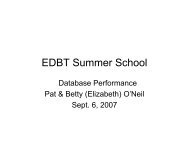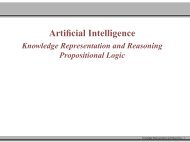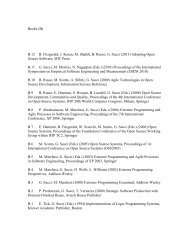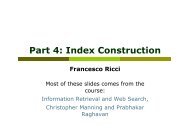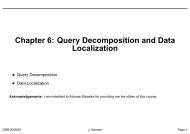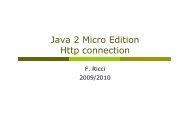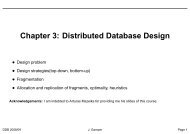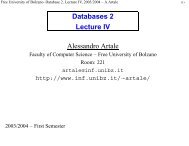Introduction to Database Systems Queries in SQL The select ...
Introduction to Database Systems Queries in SQL The select ...
Introduction to Database Systems Queries in SQL The select ...
Create successful ePaper yourself
Turn your PDF publications into a flip-book with our unique Google optimized e-Paper software.
Nested <strong>Queries</strong>: Example with exists<br />
An expression with the opera<strong>to</strong>r exists is true if the result of the<br />
subquery is not empty.<br />
Example: “Persons with at least one child”<br />
<strong>select</strong> *<br />
from person p<br />
where exists (<strong>select</strong> *<br />
from fatherChild fc<br />
where fc.father = p.name)<br />
or<br />
exists (<strong>select</strong> *<br />
from motherChild mc<br />
where mc.mother = p.name)<br />
Note: the attribute name refers <strong>to</strong> the table <strong>in</strong> the outer from clause.<br />
79<br />
Nest<strong>in</strong>g, Union, and “or”<br />
<strong>The</strong> query for “persons with at least one child” can also be expressed as<br />
a union:<br />
<strong>select</strong> p.name, p.age, p.<strong>in</strong>come<br />
from person p, fatherChild fc<br />
where fc.father = p.name<br />
union<br />
<strong>select</strong> p.name, p.age, p.<strong>in</strong>come<br />
from person p, motherChild mc<br />
where mc.mother = p.name<br />
Does the follow<strong>in</strong>g query with “or” return the same answers?<br />
<strong>select</strong> dist<strong>in</strong>ct p.name, p.age, p.<strong>in</strong>come<br />
from person p, fatherChild fc, motherChild mc<br />
where fc.father = p.name<br />
or mc.mother = p.name<br />
80



